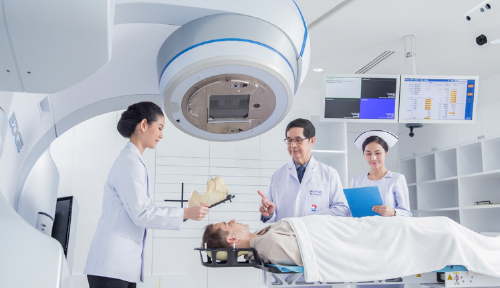Source: Wattanosoth Hospital Jul 03, 2018 7 years, 4 months, 3 weeks, 6 days, 11 hours, 13 minutes ago
The results achieved by the latest cancer treatments continue to exceed expectations. Examples include: minimally invasive surgery to remove a piece or entire suspicious tumours; chemotherapy to eliminate reproducing cells; targeted therapies to precisely stop cancer from growing and spreading by targeting at specific genes and proteins; and radiosurgery to eradicate cancerous cells.
Associate Professor Prasert Lertsanguansinchai, M.D. Radiation Oncologist at Wattanosoth Hospital (Bangkok Cancer Hospital), explained why the latest radiosurgery technology is now probably one of the most effective procedures to treat cancer, especially of the brain, spine, lungs, gastro-intestinal tracts and other organs where extreme precision is essential.
“For at least 20 years, radiation treatment has been developed in parallel with
cancer diagnosis processes that use X-ray, Computerised Tomography scan (CT Scan), Electromagnetic Resonance Imaging (MRI) and PET/CT scans to source information about the structure and function of cells and tissues.”
“In the past, conventional radiation treatment involved aiming high energy rays beam at the treatment area. But this caused loss of healthy tissue in surrounding areas and side effects. Today’s radiation methods (3D-CRT, 4D RT) are much more precise in targeting cancerous tumours. As such they are able to spare more healthy tissue, they give rise to fewer side effects, and they achieve higher cure rates.”
Seeing the key roles of modern technologies in enabling patients to enjoy a better quality of life, Wattanosoth Hospital has implemented the latest EDGE radiosurgery system that offers a real-time, all-in-one radiosurgery solution. This is achieved by pre-treatment simulation by CT or PET/CT, synchronising image, patient position, motion management, beam shape and dose delivery.
EDGE radiosurgery tracks patient’s tumours in real time for intracranial and extracranial treatments. It precisely calculates patient movement in six dimensions and monitors respiratory motion. Speed, precision and streamlined treatment planning are among its superior advantages. An advanced tool, it is expressly designed to deliver high conformity dose distributions to tumours in the lung, brain, spine and other areas of the body.
“EDGE radiosurgery equipment uses advanced technology to treat all areas of the body, especially lesions near delicate areas, such as the brain, lungs and spine, optic and auditory nerves, that require high-precision operations. Meanwhile, it generates minimal effects on surrounding healthy tissues.”
The equipment includes a cutting-edge image guide that enables oncologists to locate and track the tumour and view virtually every angle of the tumour at the time of treatment.
“Tumours don’t stay still because of breathing and other movements of the body. This advanced technology delivers precise radiation doses to the tumour while adjusting to breathing and movements of the chest, liver, bladder and bowels. When the tumour moves outside the planned treatment range, the radiation beam automatically shuts down.”
EDGE also features 120-tooth, 2.5-mm-wide multi-leaf collimators (MLC) that shield other healthy areas from radiation. Each leaf moves individually according to the patient’s specific radiotherapy treatment plan.
The
equipment enables radiation oncologist to pinpoint the target and deliver a highly focused treatment.
“These days, cancer is quite similar to diabetes and hypertension in the way it can be treated and controlled.”
Fewer sessions are necessary and treatment is administered much faster than other methods. Moreover, EDGE is suitable for use on even the smallest tumours – as small as 5mm – and each session only lasts less than 15 minutes. After all sessions are completed, the patient undergoes follow-ups to assess treatment effectiveness and recovery progress.
“Advanced technology isn’t the final answer to everything: good teamwork plays a major role in cancer care. You need highly experienced radiologists, surgeons, medical oncologists, physicists, nurses and other staff to ensure accurate planning, treatments and services suited to each individual patient’s requirements. In fact, experienced specialists covering all key areas are the most important weapon in the anti-cancer armoury.”
“These days,
cancer is quite similar to diabetes and hypertension in the way it can be treated and controlled. Although it is not as scary as before, everyone should reduce their risk of cancer by having regular cancer screening even there is no indicated sign or symptom as early detection and diagnosis significantly reduce the severity of cancer and greatly enhance the chance of successful treatment.”
For further information or medical advice, please contact Wattanosoth Hospital, Tel. 0 2310 3000 or visit www.bangkokhospital.com/wattanosoth

